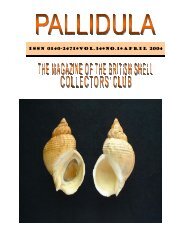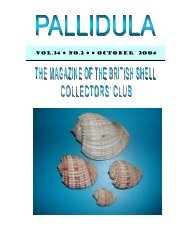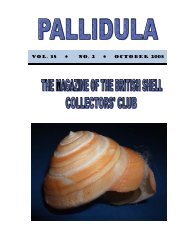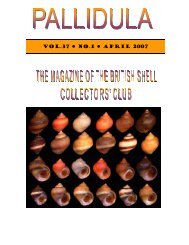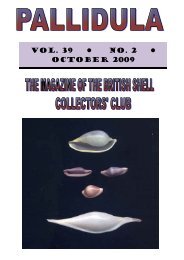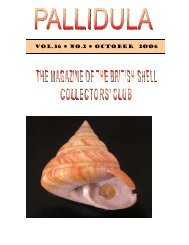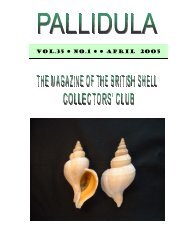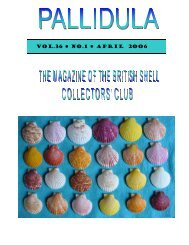VOL.35 NO.2 OCTOBER 2OO5 - British Shell Collectors' Club
VOL.35 NO.2 OCTOBER 2OO5 - British Shell Collectors' Club
VOL.35 NO.2 OCTOBER 2OO5 - British Shell Collectors' Club
You also want an ePaper? Increase the reach of your titles
YUMPU automatically turns print PDFs into web optimized ePapers that Google loves.
Page 10 PALLIDULA<br />
beside the skeletons of a woman and a 7 month old child. Cowries were believed to ensure life and<br />
resurrection 3 .<br />
Dr. Felix Lorenz (personal communication) said C. pantherina was also found in 5 th century Merowingan graves<br />
in Southern Germany. Only wealthy women had them in their graves. He was of the opinion that they came<br />
from the Yemen area.<br />
Conclusion<br />
The base of a cowry shell found in a 12 th -14 th grave near Cambridge appears to be from a shell of Cypraea<br />
pantherina. Specimens of the same species have been found in other early English and European graves. It<br />
was probably intended as a charm rather than as an ornament. Its presence suggests that the human skeleton<br />
with which it was found was probably that of a woman.<br />
Aperture<br />
The opening of a shell.<br />
Glossary<br />
Columella The central axis of a coiled shell, formed by the inner wall of the whorls and<br />
often forming a thickened inner lip.<br />
Columellar teeth Teeth along the columellar (inner) lip.<br />
Fossula A spoon-shaped depression at the anterior end of the columellar lip of a cowry<br />
shell.<br />
Gastropod A mollusc with a single shell. The shell is usually coiled (spiral).<br />
Labial teeth Teeth along the outer lip.<br />
Nominate<br />
subspecies<br />
The subspecies that represents the species as originally named, e.g. Cypraea<br />
pantherina pantherina.<br />
Pyriform Pear-shaped.<br />
Rostrate With produced, beak-line extremities.<br />
Spire The coils of a gastropod shell. In cowries, this is very small and often not<br />
visible.<br />
Subspecies A population of individuals differing significantly from other populations of the<br />
same species.<br />
Teeth Ridges that run along both edges of the aperture of a cowry shell.<br />
References<br />
Allan, J. 1956. Cowry <strong>Shell</strong>s of World Seas (Georgian House, Melbourne)<br />
Burgess, C. M. 1985. Cowries of the World (A. S. Barnes & Co., New York)<br />
Heiman, E. L. 2002. Cowries of East Sinai (Keterpress Enterprises, Jerusalem)<br />
Lorenz, F., 2002. New Worldwide Cowries (Conchbooks, Hackenheim, Germany)<br />
Lorenz, F. and Hubert, A. 2 nd ed., 2000. A Guide to Worldwide Cowries (Conchbooks, Hackenheim, Germany)<br />
Naerbeth, C. November, 2004. The Cowry <strong>Shell</strong> as Money, in Mollusc World Issue 6 (Conchological Society of<br />
Great Britain and Ireland)<br />
Taylor, J. and Walls, J. G. 1975. Cowries (T. F. H. Publications, New Jersey)<br />
Acknowledgements<br />
Thanks are due to John Batt for assistance with identification and with the determination of the degree of<br />
maturity of the shell, and for reviewing the final draft. I would also like to express my gratitude to Dr. Felix<br />
Lorenz for information on the longevity of C. pantherina and on its occurrence in early German graves, and to<br />
Archaeological Solutions for permission to reproduce this article in Pallidula.<br />
3 Allan, J. 1956. Cowry <strong>Shell</strong>s of World Seas, page 6.



